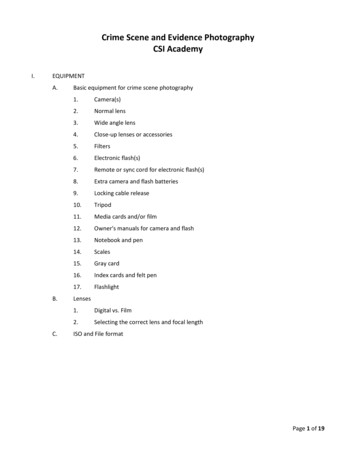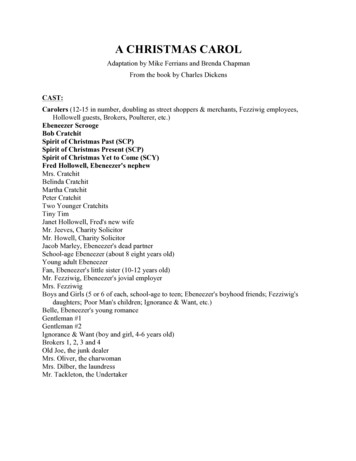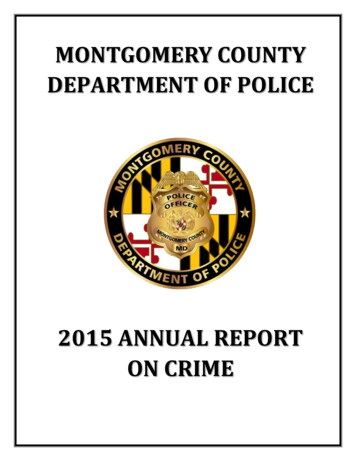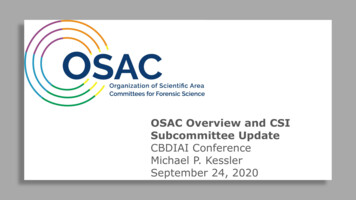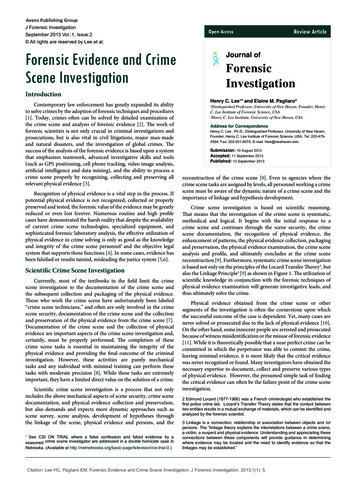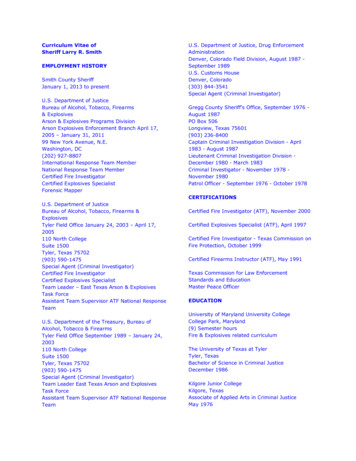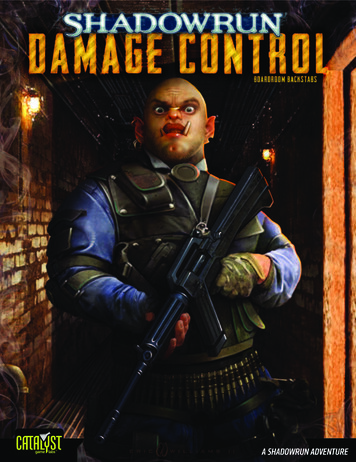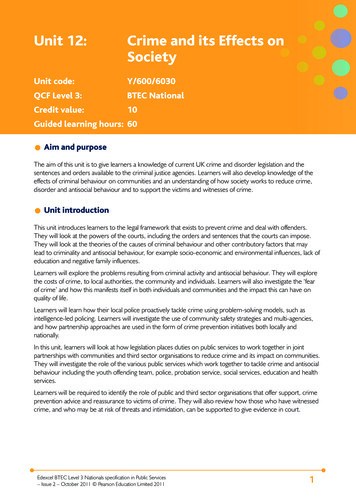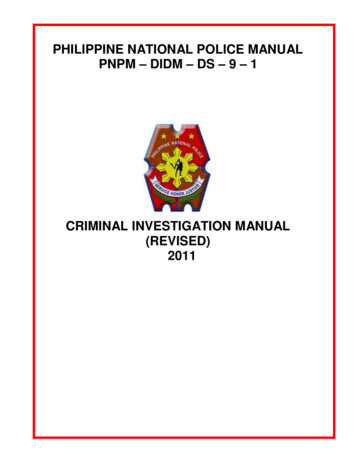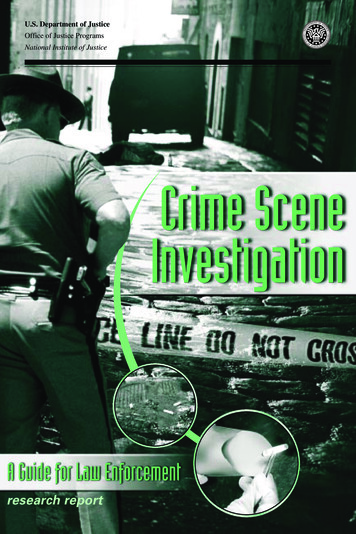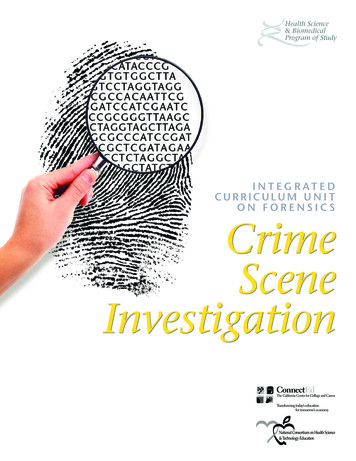
Transcription
Health Science& BiomedicalProgram of StudyI N T E G R AT E DCURRICULUM U N I TON FORENSICSCrimeSceneInvestigation
ConnectEd: The California Center for College and Career2150 Shattuck Avenue, Suite 1200Berkeley, CA 94704510-849-4945FAX: 510-841-1076www.ConnectEdCalifornia.orgNational Consortium on Health Science and Technology Education2410 Woodlake DriveOkemos, MI 48864-3997www.nchste.orgCopyright 2007 by ConnectEd: The California Center for College and Career. All rights reserved.Pages from this unit may be reprinted or photocopied for free distribution, with attribution toConnectEd: The California Center for College and Career and the National Consortium on Health Scienceand Technology Education.Contributing Teacher Team:Westinghouse Career AcademyChicago, ILContributing ConnectEd Staff:Director for Program and Curriculum Development: Paula HudisCurriculum Developers: Pier Sun Ho (Lead), Khanh Bui, Aaron Malloy, Charles StephenPublishing/Editorial Staff: Barbara Kridl, Andrea Livingston, Natesh Daniel, Patti Gildersleeve,Alicia Broadway, Leslie Tilley, Dave Abston, Goura Fotadar McCarty, Becky Chapman-WinterAdministrative Staff: Melody RoseContributing NCHSTE Representatives:Health Science and Biomedical Program of Study Project Director: Beverly CampbellExecutive Director: Carole StacyCoordination, Site Sponsorship, and Teacher Team Support: Nancy Allen, SeAnne Safaii, Cindy Beck,Fran Beauman, Rhonda Patterson, Karen Batchelor, Thalea Longhurst, Jen Staley, Michael Mitchell,Clarice Morris, Scott Snelson, Bruce Bird, Paul Jackson
AcknowledgmentsConnectEd: The California Center for College andCareer and The National Consortium on Health Science and Technology Education (NCHSTE) want tothank the many people who supported this work andhelped develop these integrated curriculum units.We would especially like to thank the academic andhealth science teachers from 12 high schools whoparticipated in our curriculum design workshops andcreated and tested many of the original lessons intheir classrooms. We also want to thank the principalsof these schools for encouraging curriculum integration and supporting their teachers’ work. Enthusiasticand creative teachers and supportive administratorshave been essential to the success of the project.The following high schools participated at variousstages of the project:CaliforniaArthur A. Benjamin Health Professions High School(Sacramento)Palmdale High School, Health Careers Academy(Palmdale)IdahoMeridian Medical Arts Charter High School (Boise)IllinoisWestinghouse Career Academy (Chicago)Dunbar Career Academy (Chicago)New Millennium School of Health (Chicago)IndianaOwen Valley High School (Spencer)MinnesotaJohn Marshall High School (Rochester)New YorkGorton High School Academy of Medical Professions(Yonkers)South CarolinaBeaufort High School (Beaufort)TexasBen Barber Career and Technology Academy (Mansfield)UtahNorthridge High School (Layton)We also want to thank many contributing representatives from NCHSTE and local school districts whohelped coordinate beta testing activities, sponsoredschool sites, and provided support to the teachers. These individuals include Nancy Allen, KarenBatchelor, Fran Beauman, Cindy Beck, Bruce Bird,Jan Cabbell, Paul Jackson, Thalea Longhurst, RhondaPatterson, Michael Mitchell, Clarice Morris, SeAnneSafaii, Scott Snelson, and Jen Staley. Carole Stacy,NCHSTE’s Executive Director, played many essentialroles at every stage of this work.Thanks, also, to Intermountain Healthcare, Salt LakeCity, Utah and the Mayo Clinic, Rochester, Minnesota. Both of these organizations generously providedfacilities and opportunities for guided study toursthat were an important component of our teacherprofessional development workshops.A talented group of curriculum designers at ConnectEdworked with the original lessons created by theteacher teams and expanded their material to createfull curriculum units. The team was led by Pier SunHo, and also included Khanh Bui, Aaron Malloy, andCharles Stephen.We gratefully acknowledge the publishing, editorial,and design work provided by MPR Associates, Inc.staff, including Barbara Kridl, Andrea Livingston,Natesh Daniel, Patti Gildersleeve, and Alicia Broadway. They were assisted by Leslie Tilley, Dave Abston,Goura Fotadar McCarty, and Becky Chapman-Winter.Melody Rose ably provided project administrativesupport.Major funding for this work came from the JamesIrvine Foundation and from MPR Associates, Inc.The State Directors of Career Technical Education inCalifornia, Idaho, Illinois, Indiana, Minnesota, SouthCarolina, Texas, and Utah, along with the Directorof Career Development and Occupational Studies,Yonkers (New York) Public Schools provided fundingfor teacher professional development and classroombased curriculum design and testing. We were fortunate to receive seed money at the start of the projectfrom The Office of Vocational and Adult Education atthe U.S. Department of Education.Crime Scene Investigationiii
AcknowledgmentsFinally, we want to thank two individuals whoprovided tremendous support for this effort. AnneStanton, Director of the Youth Program at the JamesIrvine Foundation and Gary Hoachlander, Presidentof ConnectEd and MPR Associates, Inc. have promoted a new way of thinking about how to engagestudents in learning with the goals of improving academic outcomes and closing the achievement gap.They have encouraged us to create interdisciplinarycurriculum material that delivers challenging, college- and career-preparatory academic and technicallearning through authentic, career-focused applications. We hope that using this curriculum enlivensyour classroom, excites your students to learn, andhelps them achieve academic and career success.Paula M. HudisDirector for Program and Curriculum Developmentand Project Director forConnectEdBeverly CampbellPrincipal, BECGroup Consulting andHealth Science and Biomedical Program of StudyProject Director, NCHSTESeptember 2007Crime Scene Investigation iv
Crime Scene InvestigationCONTENTSPageUnit Overview1Subunit 1 OverviewLesson 1.1Lesson 1.2Lesson 1.3Murder Most FoulHealth ScienceEnglish Language ArtsHealth ScienceSubunit 2 OverviewLesson 2.1Lesson 2.2Lesson 2.3Lesson 2.4Lesson 2.5.Crime Scene InvestigationsAlgebra IAlgebra IIGeometryBiology/Health ScienceBiologySubunit 3 OverviewLesson 3.1Lesson 3.2Lesson 3.33Introduction to Forensic Investigations . . . . . . . .You Be the Detective: Sherlock Holmes and Deductive ReasoningMurder in the Classroom . . . . . . . . . . . .Lengthy Relationships . . . .Time of Death: The Law of CoolingSuspect Radius . . . . . .Blood Typing . . . . . .DNA Fingerprinting . . . .21.Gathering Evidence, Bringing Justice . .On the Case: Interviews With Professionals.The Closing Argument . . . . . .Convincing the JuryWorld HistoryEnglish Language ArtsEnglish Language Arts51317232731353949515761National Healthcare Foundation Standardsthat apply to this unit include:s !CADEMIC &OUNDATIONSs #OMMUNICATIONSs )NFORMATION 4ECHNOLOGY !PPLICATIONSs 4EAMWORKs ,EGAL 0RACTICESCrime Scene Investigation v
Crime Scene InvestigationUNIT OVERVIEWEssential Question for This UnitCulminating EventWhat are the appropriate roles for scientific technology and human judgment in arriving at verdicts incriminal cases?Because this unit focuses on solving a crime, themost logical culminating event would be to conducta trial. Some students can assume the role of lawyers,preparing opening and closing statements that summarize the strengths and weaknesses of the case andthe evidence. Other students can assume the roleof police officers and scientific experts called as witnesses to testify.Unit SummaryIn this unit, students take on the role of crime sceneinvestigators to solve a murder that has occurred atthe school. They will integrate math, science, andlanguage arts into the study of forensic science andassociated health science careers such as pathology,forensic science, and medical examination.In Subunit 1, students are introduced to the unit andthe task of crime scene investigation. They will readand analyze a classic mystery, The Blue Carbuncle. Students will also learn about the techniques of variousbranches of forensic science and how advances inbiotechnology have helped to solve crimes.In Subunit 2, students will learn and apply the various techniques used during a crime scene investigation, including what types of evidence to collect andhow that evidence can be used to deduce information about the crime and/or perpetrator. In this unit,students will learn such investigative strategies asmeasuring stride length from footprints left at thescene to calculate height; using the victim’s temperature to estimate the time of death; and collectingblood and other DNA samples from the scene in order to conduct a variety of biological tests—includingblood typing and DNA fingerprinting that can matcha suspect to the crime.In Subunit 3, students examine the results of forensicscience. In World History, they examine how forensicscience has been used not only to solve individualcrimes, but also to shed light on crimes against humanity. In English Language Arts, students interviewprofessionals engaged in various aspects of forensicscience. They also will marshal the evidence fromtheir own investigations into a case against the primary suspect. Students will write up their arguments,as well as present them orally.Key Questions/Issuess7HAT TALES CAN DEAD MEN TELL 7HAT CAN YOU LEARNabout a crime by examining the victim? (HealthScience, Biology, Algebra I and II, Geometry)s7HAT KINDS OF CLUES AND EVIDENCE CAN BE GLEANEDfrom a crime scene? What types of evidence areleft behind? (Health Science)s7HAT FACTORS AND EVIDENCE SHOULD BE USED TO DEtermine a person’s guilt? Is some evidence betteror worse than others? (Health Science, EnglishLanguage Arts)sShould circumstantial evidence play a role? Why orwhy not? (English Language Arts, Health Science,World History)sWhy take the temperature of a dead body? (Algebra II)s(OW HAVE ADVANCES IN .! TECHNOLOGY HELPED TOensure justice is being served? (Biology)s3HOULD JURIES RELY SOLELY ON .! EVIDENCE IN DEtermining the guilt of accused individuals in capital murder cases? How reliable is DNA evidence?(English Language Arts, Health Science)Learning Scenario to Kick Off the UnitA young man has been found dead in an unusedclassroom with a knife stuck in his chest. A groupof three students found the body this morning. Thedeceased was on his back when discovered, and theroom was in a little bit of disarray, chairs turned overand desks shoved out of place. Bloody footprints andthe murder weapon were left at the scene!Crime Scene Investigation 1
Crime Scene InvestigationUNIT OVERVIEWEveryone in school is shocked and wondering whathappened. When the name of the victim is released,it turns out that he was a former student who graduated last year, and not a very popular one at that!He had a history of trouble with teachers, administrators, and other students—probably with othersas well—so the list of suspects might be very long.When the police arrive, the crime scene investigatorsgo to take a look at the scene. What will the policebe doing to solve the crime and to ensure that theyhave the right perpetrator?Biomedical/Healthcare and EducationPartner Roless&ORENSIC SCIENTISTS FROM THE LOCAL COMMUNITY CANbe invited to speak to students in greater depthabout their job and training.s3TUDENTS CAN VISIT LOCAL HOSPITALS OR OTHER MEDICALfacilities with pathology labs.s!DDITIONAL SPEAKERS THAT CAN BE INVITED TO PARticipate in the units and/or culminating eventinclude:s"LOOD "ANK 4ECHNICIANs#LINICAL ,ABORATORY 3CIENTISTs-EDICAL 4ECHNOLOGISTs(EMATOLOGIST PHYSICIAN WHO SPECIALIZES INblood disorders)s4OXICOLOGISTs0ATHOLOGISTs ENTISTSUBUNITS AND MAJOR TOPICS (ACROSS ACADEMIC AND TECHNICAL SUBJECT AREAS)Subunit 1Murder Most FoulSubunit 2Crime Scene InvestigationsSubunit 3Convincing the JuryHEALTH SCIENCE · ENGLISH LANGUAGEARTSALGEBRA I · ALGEBRA II · BIOLOGY ·GEOMETRY · HEALTH SCIENCEENGLISH LANGUAGE ARTS · WORLDHISTORYs #AREERS IN FORENSIC SCIENCEs 2ATIOS AND PROPORTIONSs 4ECHNIQUES OF FORENSIC SCIENCEs ,INEAR EQUATIONSs )NVESTIGATION OF WAR CRIMES AND CRIMESAGAINST HUMANITYs ,ITERARY ANALYSIS INCLUDING IDENTIFYING ORINFERRING THE CENTRAL IDEA PURPOSE ORTHEME AND IDENTIFYING LITERARY DEVICESAND TECHNIQUES PARTICULARLY THOSE ASSOCIATED WITH MYSTERIESs 'RAPHING THE EQUATION OF A CIRCLEs 2EASONING AND PROBLEM SOLVINGs ERIVING FROM THE DISTANCE FORMULAs ,OGARITHMIC EQUATIONSn.EWTON S ,AWOF #OOLINGs .! STRUCTURE AND PURPOSEs "LOOD TYPINGs !FTERMATH OF 7ORLD 7AR )) AND THE.UREMBERG 4RIALSs 0ERSUASIVE COMPOSITION WRITING WITHSTRUCTURED ARGUMENTSs ELIVERY OF PERSUASIVE ARGUMENTS USINGRHETORICAL DEVICES TO SUPPORT ASSERTIONSs .! lNGERPRINTINGs 'EL ELECTROPHORESISCrime Scene Investigation 2
Murder Most FoulSUBUNIT 1 OVERVIEWEssential Question for This UnitSubunit Key QuestionsWhat are the appropriate roles for scientific technology and human judgment in arriving at verdicts incriminal cases?s(OW ARE THE PROCEDURES USED TO COLLECT EVIDENCEfrom violent crime scenes similar to and differentfrom what we see on television? (Health Science)s(OW ARE CRIMINAL INVESTIGATIONS PORTRAYED IN LITERature? Is Sherlock Holmes really a great detective?Can you find errors in the conclusions he drawsfrom evidence? (English Language Arts)s7HAT KINDS OF EVIDENCE CAN BE LEFT AT A CRIMEscene, and what can be learned? (Health Science)s7HAT ARE EARLY EXAMPLES OF FORENSIC INVESTIGAtion? How has forensic science advanced inrecent years? What techniques have been developed and which ones are falling out of use?(Health Science)Subunit GoalsSubunit 1 introduces the topic of forensic science. Inthis subunit, students learn about the range of fieldswithin forensic science and the basic investigatorytechniques used in a criminal investigation. Studentsalso discuss reasoning from evidence in literature, inthe form of a classic mystery story, The Blue Carbuncleby Sir Arthur Conan Doyle. In Lesson 1.3, studentsare taken to a “crime scene” within the school andasked to investigate. Students will collect evidencefrom the scene following the guidelines they havestudied. They then analyze the collected evidence inSubunit 2.Lesson SummariesLessonSubjectDescription1.1(EALTH 3CIENCEIntroduction to Forensic Investigations3TUDENTS ARE INTRODUCED TO THE lELD OF FORENSIC SCIENCE 4HEY ARE GIVEN A BRIEF OVERVIEWOF THE HISTORY OF FORENSICS AND LEARN THE BASIC PROCEDURES FOLLOWED IN A MODERN MURDERINVESTIGATION 3TUDENTS ALSO USE THE )NTERNET TO DISCOVER THE MANY BRANCHES OF FORENSICscience.1.2%NGLISH ,ANGUAGE !RTSYou Be the Detective: Sherlock Holmes and Deductive Reasoning3TUDENTS DISCUSS THE CHARACTERISTICS OF THE MYSTERY GENRE AND RELATE THEIR DISCUSSION TOTHE SHORT STORY The Blue Carbuncle &OLLOWING A CLOSE READ OF THE STORY STUDENTS IDENTIFYEXAMPLES OF FAULTY REASONING USED BY THE MAIN CHARACTER 3HERLOCK (OLMES 1.3(EALTH 3CIENCEMurder in the Classroom! MURDER IS DISCOVERED IN THE CLASSROOM AND STUDENTS ARE TAKEN TO INVESTIGATE THESCENE 3TUDENTS OBSERVE THE CRIME SCENE AND COLLECT PHYSICAL EVIDENCE FOR ANALYSIS INLATER LESSONS Crime Scene Investigation 3
Subunit 1—Murder Most FoulIntroduction toForensic InvestigationsLESSON 1.1HEALTH SCIENCEEssential Question for This UnitTimeWhat are the appropriate roles for scientific technology and humanjudgment in arriving at verdicts in criminal cases? MINUTESMaterialsEquipment#OMPUTER LABResourcess h#RIME 3CENE 3EARCH v &")Handbook of Forensic Services(HTTP WWW FBI GOV HQ LAB HANDBOOK INTRO HTM)s &ORENSIC 3CIENCE 3UBDIVISIONSHANDOUTs Forensic Science Timeline(HTTP WWW FORENSICDNA COM 4IMELINE PDF)s Crime Scene Investigation: AGuide for Law Enforcement(HTTP WWW FBI GOV HQ LAB FSC BACKISSU APRIL TWGCSI PDF)Prior Student Learning!SK STUDENTS TO VIEW AN EPISODE OFA CRIME INVESTIGATION 46 PROGRAMAND REVIEW THE Forensic ScienceTimeline BEFORE BEGINNING THELESSON ObjectivesAfter completing this lesson, students should be able tosDescribe the range of work in forensic science, including careers thatuse forensic science techniques.sIdentify major procedures used in conducting a crime scene investigation and explain the importance of following procedures.sDemonstrate multiple ways to collect forensic evidence while preserving the crime scene.Lesson ActivitiesLesson SpringboardMany believe that TV shows such as Law & Order and CSI: Crime SceneInvestigation have produced something called the “CSI effect.” Thatis, victims of crimes, jurors, and members of the general public haveheightened expectations about what can be revealed from the evidencethat is presented in trials. Some argue that this phenomenon is responsible for the increased use of forensic evidence in criminal cases.Modern advances in forensic science (forensics) have transformed previously unusable clues into highly reliable evidence. Today, many “coldcases” from the past aren’t that cold anymore. For instance, in 1996, using advances in DNA technology, California created a DNA database ofcriminal offenders. They reopened cold cases to see whether this DNAevidence would help resolve the cases. Results have been promising. Forexample, the offender database linked Gerald Parker, a man already serving a prison sentence for rape, to a 17-year-old murder case. Confrontedwith the evidence, Parker not only confessed to that crime, but also tofive other murders.Forensic scientists have not only solved cold cases, but also reopened“solved” cases. The Innocence Project, a nonprofit legal clinic reportsthat 205 people have been exonerated due to DNA evidence. In the caseof Gerald Parker, after his confessions, another man (the husband ofone of Parker’s victims) was freed after serving 16 years in prison for thewrongful conviction in the assault of his pregnant wife and murder ofher unborn fetus, which Parker committed.A Brief HistoryDNA evidence is just one tool in forensic scientists’ toolbox. The firstwritten record of forensic science can be traced back to ancient China inCrime Scene Investigation 5
Subunit 1—Murder Most FoulIntroduction to Forensic InvestigationsLESSON 1.1a book written in 1248 titled “Xi Yuan Ji Lu” (translated as Collected Cases of Injustice Rectified) by Song Ci. This book describes the investigationof a person murdered with a sickle (a cutting tool). All suspects were toldto bring their sickles to a central location, where it was noticed that flieswere attracted to one particular sickle, presumably by the smell of blood;this led to a confession by the owner of that sickle.Archimedes (287 BC–212 BC), a Greek mathematician, is often creditedas the “father” of forensics due to reportedly being asked to determinethe purity of a gold crown without melting or destroying it. While taking a bath, he noticed that his body always displaced a certain amountof water. Archimedes recognized that a supposed pure gold crown mustnot only weigh the same as an authenticated one, but also displace thesame amount of water as an equal weight of pure gold.Fingerprints were recognized in the prehistoric era and became an identifier in criminal cases in the late 19th century. The earliest documentedcases of forensic ballistics, toxicology, pathology, and biology also occurred in the 19th century. Today, DNA evidence has established a newstandard—one can only wonder what the future will hold. In 1913, thepolygraph examination (lie detector test), which measures physiological responses (blood pressure, perspiration, pulse, and so on) to verbalstatements, was created; it’s routinely used by law enforcement officialsthough test results are not admissible in many courts. Now, a new lie detection technology has been created called Brain Fingerprinting. It reportedly measures the presence of indicators of memory in a person’s brain,and it has already been used in court cases.Lesson DevelopmentDirect Instruction“Investigators should approach the crime scene investigation as if it willbe their only opportunity to preserve and recover these physical clues,”according to the manual Crime Scene Investigation: A Guide for Law Enforcement. In this class, students should be introduced to the basic protocol for conducting forensic science investigations and the importance offollowing it.Explain to students that the goal of most crime scene investigations is toanswer some or all of the following questions:sWho is the perpetrator, and who is the victim?sWhat happened, when, and why?sHow did the crime happen?sWhere did it happen (the location of the body is not always at theprimary crime scene)?sWhat is the evidence?Ask students what types of evidence would be found at a crime scenein which a victim was murdered with a knife. Students may mentionCrime Scene Investigation 6
Subunit 1—Murder Most FoulIntroduction to Forensic InvestigationsLESSON 1.1fingerprints, the murder weapon, DNA evidence, and so on. Write theirresponses on the board. Inform students that a brief examination ofthe scene will often provide a general theory of what occurred, whileforensics often reveals hidden clues. Body temperatures can be used toapproximate the time of death, as well as any insect found in or on thebody (the stage of development of fly larvae can also indicate the timeof death). If there is blood, DNA can be analyzed. Also, hand or shoeprints can be analyzed to provide the approximate height and stride ofthe suspect. Both time of death and the suspect’s stride can be used toapproximate a radius that the suspect must be in. Investigators use manytypes of clues together to narrow down the potential pool of suspects.Ask students what is the best way to find this evidence. If officers rush tothe scene to collect the murder weapon, it’s possible that they may destroyother evidence such as footprints. Explain to students that crime sceneinvestigators often work in teams and follow an established procedure.Explain the following specialized set of protocols for a crime scene investigation:1.APPROACHING—Carefully observe persons, odors, and other elements. Exercise extreme safety.2.CONFIRM OR DISCONFIRM DEATH—Locate and view the body,noting the success, failure, or futility of resuscitative efforts.3.PRESERVING—Establish perimeters. Set up command posts. Determine the suspect’s point of entry and egress and your own.4.PROCESSING—Photograph scene, body, and face. Place and photograph markers. Photograph body. Sketch and search the scene.Examine evidence in detail. Take notes. Tag and bag. Describe anddocument.5.IDENTIFY THE VICTIM—Estimate cause, manner, and time ofdeath. Obtain exemplars and controls. Look for ID. Look for dragmarks. Note discrepancies in mortis and body temperature.6.NOTIFY NEXT OF KIN (and be prepared to assist the family throughan autopsy and provide financial advice).7.DEVELOP THEORY OF MOTIVE—Rely upon evidence, knowledgeof victim’s activities, and appearance of victim’s clothing. See if anydocuments were written by or sent to victim recently. Determinethe pre-scene activity and health status (physical and mental) of thevictim.8.SEEK ADDITIONAL INFORMATION—Do background and historychecks (marital, family, sexual, employment, financial, daily routine, friends, religion, education, and criminal history). Obtain leadsfrom people who knew the victim. Challenge discrepancies in witness’ knowledge of the victim or lack of corroboration with otherwitnesses. Order warrants on suspects.Crime Scene Investigation 7
Subunit 1—Murder Most FoulIntroduction to Forensic InvestigationsLESSON 1.19.QUESTIONING—Question all suspects. Make use of evidence duringquestioning. Use information withheld from the public about thecase to obtain a confession. Destroy alibis.SOURCE: “An Introduction to Crime Scene Analysis” m)(This website also provides many additional Internet resources aboutcrime scene investigations.)Small Group WorkAssemble students into groups of four. Have them print the seven-pagedocument “Crime-Scene Search” from the FBI’s Handbook of Forensic Services (http://www.fbi.gov/hq/lab/handbook/intro16.htm). Each studentgroup will include asPerson in charge (team leader)sPhotographersSketch preparersEvidence recorderUsing the “FBI Crime-Scene Search” information as a reference, eachstudent should write a one-half to one-page summary of the duties theywould perform in their assigned role at a crime scene investigation. Theyshould also describe how their duties combined with those of otherstudents in their group would contribute to the overall quality and effectiveness of the investigation.At the conclusion of this assignment, pass out the Forensic Science Subdivisions handout and provide students with Internet access to fill in thechart (students can also work in groups). Explain that many other fieldsof forensics are not included on the list and that they should list anyadditional subdivisions.Lesson ClosureAsk students if they understand why it is important to follow protocoland conduct careful investigations or if they know of any court caseswhere the forensic evidence collected was tainted or discredited due toimproper investigative procedures. Some students may mention the O.J.Simpson murder trial in which he was acquitted of criminal liability butfound liable for the crime in a civil court.Possible Prior MisconceptionsMost students will probably link forensics with crime due to popular TVshows. Yet, forensic science is any science used in the courts, the justicesystem, or in public investigations, and these investigative methods canbe used in many situations beyond criminal cases.Students should understand that crime scene investigations usuallyrequire a team of forensic scientists who do most of their work in laboCrime Scene Investigation 8
Subunit 1—Murder Most FoulIntroduction to Forensic InvestigationsLESSON 1.1ratories because this work requires knowledge of several scientific disciplines: often one person lacks the necessary educational background andexpertise to conduct the entire investigation alone. This scenario is illustrated well on popular TV shows. For example, a ballistics expert may bea physicist and a forensic pathologist will be a medical doctor, while thescientist analyzing blood samples may be a chemist or biologist.Student Assessment ArtifactsSummary of dutiesForensic science subdivisions handoutVariations and ExtensionsA law enforcement officer or forensic scientist can speak to the classabout crime scene investigation and provide details about occupationsin Forensics.Students can be selected to present their summaries to the class (one student can be selected from each position) to ensure their overall understanding of the investigative process.National and State Career Technical Education StandardsNATIONALNCHSTE National Healthcare Skill StandardsCALIFORNIASTATE,IST YOURScienceHealthSTATE SPECIlCand STANDARDSMedical TechnologyIN THE SPACE BELOW StandardsFoundation Standard 4: Employability Skills(EALTHCARE WORKERS WILL UNDERSTAND HOW EMPLOYABILITY SKILLSENHANCE THEIR EMPLOYMENT OPPORTUNITIES AND JOB SATISFACTION 4HEY WILL DEMONSTRATE KEY EMPLOYABILITY SKILLS AND WILLMAINTAIN AND UPGRADE SKILLS AS NEEDED 5.0 Problem Solving and Critical Thinking3TUDENTS UNDERSTAND HOW TO CREATE ALTERNATIVE SOLUTIONS BYUSING CRITICAL AND CREATIVE THINKING SKILLS SUCH AS LOGICAL REASONING ANALYTICAL THINKING AND PROBLEM SOLVING TECHNIQUES &ORMULATE SOLUTIONS TO PROBLEMS USING CRITICAL THINKINGSKILLS ANALYZE SYNTHESIZE EVALUATE INDEPENDENTLY ANDin teams.Crime Scene Investigation 9
-URDER -OST &OUL ,ESSON .AME ATE 0ERIODForensic Science Subdivisions5SE THE )NTERNET TO lLL IN THE FOLLOWING CHART !DD ADDITIONAL lELDS IF YOU lND THEM FORENSIC FIELDDEFINITION(all related to legal issues)EXAMPLES(general or specific applications)&ORENSIC !CCOUNTING&ORENSIC !NTHROPOLOGY&ORENSIC "ALLISTICS&ORENSIC "IOLOGY&ORENSIC ENTISTRY&ORENSIC OCUMENT %XAMINATION&ORENSIC %NGINEERING&ORENSIC %NTOMOLOGY&ORENSIC 0ATHOLOGY&ORENSIC 0SYCHOLOGY&ORENSIC 4OXICOLOGYCrime Scene Investigation #ONNECT%D 4HE #ALIFORNIA #ENTER FOR #OLLEGE AND #AREER#RIME 3CENE )NVESTIGATION
-URDER -OST &OUL ,ESSON .AME ATE 0ERIODForensic Science Subdivisions (Answer Key)5SE THE )NTERNET TO lLL IN THE FOLLOWING CHART !DD ADDITIONAL lELDS IF YOU lND THEM FORENSIC FIELDDEFINITION(all related to legal issues)EXAMPLES(general or specific applications)Forensic AccountingUses accounting, auditing, andinvestigative skillsEnron accounting scandal, MarthaStewart insider trading caseForensic AnthropologyAnalyzes skeletal remainsMass graves, determine lifestyle,gender, cause of deathForensic BallisticsExamines firearms, bullets, andother projectilesJFK and MLK assassination bulletidentity and trajectoryForensic BiologyAnalyzes results from serological,DNA, and other bodily fluid testsDNA and blood typing, O.J. Simpson murder trialForensic DentistryExamines dental evidenceDetermine age or identify victim orsuspect through dental recordsForensic Document ExaminationExamines printed and written material for dating and authenticityIdentify forgeriesForensic EngineeringExamines products, materials,components, and structuresDetermine the cause of plane crashor bridge collapseForensic EntomologyAnalyzes insect evidenceUse insects to determine the timeof deathForensic PathologyUses medical knowledge to examine damage from disease or injuryIdentify the fatal wound or injuryForensic PsychologyApplies psychology to issuesProvide criminal profile or determine suspect confidenceForensic ToxicologyUses chemistry and pharmacology toperform examinations for drugs andpoisonsDetermine if d
forensic science, and medical examination. In Subunit 1, students are introduced to the unit and the task of crime scene investigation. They will read and analyze a classic mystery, The Blue Carbuncle. Stu-dents will also learn about the techniques of various branches of forensic science a
